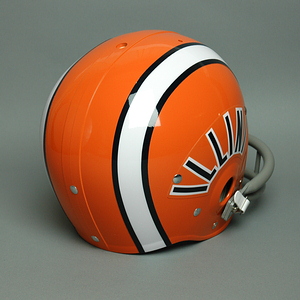
University of Illinois
1971 - 76
Illini
(Authentic Reproduction)
The Illini hired a legend, Dartmouth coach Bob Blackman who had
compiled an enviable 150-49-8 record, 104-37-3 in his sixteen years at the
Ivy League school. A proven winner who had started as a student assistant
at USC after first winning the freshmen team MVP and then being stricken
with polio, Blackman immediately changed the uniform and dropped the first
six games of his Illinois career, going scoreless in the initial
three. However, as his team responded to his new demands, they roared
through their final five games and compiled a 5-3 conference mark. QB Mike
Wells and center Larry McCarren formed the nucleus of a promising offense.
The helmet was given a very unique and attractive look using the
traditional burnt orange shell and adding one-inch white rainbow type side
stripes that were trimmed in blue and an arched "Illini" logo on each side
of the helmet in two-inch tall letters, also in blue and trimmed in white.
As Coach Blackman was preparing to improve upon his first season's record,
he was struck by the news that his team was gutted by the loss of twelve
players who had been ejected from school due to academic failures. With a
tough non-conference schedule that included USC, Washington, and Penn
State, he was lucky to survive '72 with a 3-8 record. QB Mike Wells and
center Larry McCarren (who went on to play for the Packers for twelve
years), again formed the heart of the offense with Wells graduating with
Illini career records of 2750 yards passing and 3204 total yards. Soph RB
Lonnie Perrin was the team MVP as a fleet rusher and adding a fifty-two
yard field goal to his resume. When your kicker, Danny Beaver is the
primary offensive weapon and the team cannot score a touchdown in three
consecutive mid-season games, there will be problems. 1973's 5-6 slate was
an improvement but Illinois was not scaring anyone. Beaver kicked a Big
Ten tying five FG's against Purdue in a 15-13 win. Lonnie Perrin hurt his
shoulder early and contributed but 398 yards for the year. The defense
looked good, especially DB Mike Gow who led the nation with ten
interceptions as an All Conference performer, and pushed the team total to
23 INT's and another 22 fumbles recovered. 1974 allowed the Illini to
celebrate their first winning season since 1965, a 6-4-1 mark with an
offense that picked up the slack of a defense that fell far short of the
'73 performance. Brooklyn's Revie Sorey was a tough guard who played for
the Bears, leading Walter Payton during a nine-year pro career. New QB
Jeff "Beat The Clock" Hollenbach often did, pulling out a few close
victories. HB Lonnie Perrin was lost for the year with torn knee ligaments
as was DT Scott Studwell. John DiFeiciantonio tied for the Big Ten sack
total with eleven. Expected improvement wasn't there and the team fell to
5-6 in '75, although RB Lonnie Perrin avoided injury and had a good year,
good enough to take his 223 pounds to the Denver Broncos and Redskins from
1976 through '79. QB Kurt Steger did well and the defense was promising
with Scott Studwell moving to LB. DT John DiFeliciantonio was the Big Ten
sack leader. 1976 was a repeat 5-6 season with QB Kurt Steger throwing for
1243 yards and ten TD's, less than expected. LB Scott Studwell was All Big
Ten and the defensive leader, finishing his career with a school record
177 tackles. He matriculated to the Vikings and played there from 1977
through 1990 as one of their most popular players. With disappointment and
frustration, Blackman was released and the College Football Hall Of Fame
coach returned to the Ivy League to coach Cornell until his retirement in
1982.
If interested in any of these UI helmets please click on the
photos below.


